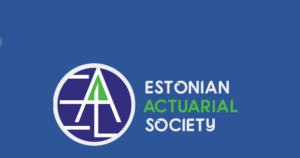Estonian Actuarial Society
You will find here information about our society and find out who is an actuary.
Who or what is an actuary? This profession is mostly confused with the similarly sounding profession of an archivist. However, unlike archivists, the playing ground of actuaries comprises mathematics, statistics, economics processes, forecasting, risk management and modelling, etc.
Actuaries mainly work in the fields of life assurance and insurance against loss and damage, but also in the fields of investment, consultancy, state agencies, academic sector and certainly insurance supervision. Actuaries working in the field of insurance are usually responsible for insurance payments, technical provisions, solvency (Solvency II) of insurance providers and so on.
To ensure relevant and reliable governance of an insurance undertaking, effective law in Estonia requires the insurance undertaking to have an efficient system of governance including actuarial function. A person carrying out the actuarial function must possess and, if necessary, be able to demonstrate the knowledge and experience in the field of insurance and financial mathematics, commensurate with the nature, scale and complexity of the risks inherent in the activities of the insurance undertaking. Membership in the Estonian Actuarial Society (hereinafter also the EAS) helps to prove the actuarial education’s compliance with international standards and, therefore, the compliance of qualifications with the law.
EAS has linked actuarial qualification requirements to the membership status in the organization. In order to obtain the status of full member in the EAS, the candidate is required to have completed the whole program of actuarial education, to have higher education and at least two years of actuarial work experience. Supervision over the compliance of candidates with the qualification requirements is the responsibility of the educational committee of the EAS.
The EAS program of actuarial education meets modern international requirements. The program structure is hierarchical, and the membership status is directly linked to the scope of advancement of the actuarial education program. The EAS program of actuarial education can be broadly divided into two – the level of base education and the level of general applications of insurance and financial mathematics.
The level of base education comprises base courses in mathematics, probability theory, mathematical statistics, incidental processes, computer science, economic sciences and accounting. The courses are complemented by the requirements on communication skills, foreign languages and knowledge of institutional structures of the EU and Estonia. These subjects are expected to be mastered during the completion of higher education. Base knowledge of insurance and financial mathematics can also be obtained by completing different degree-level courses. Upon the completion of base education, the candidate can apply for the status of the EAS associate member.
In order to apply for full membership, the candidate is additionally required to have completed the level of general applications of insurance and financial mathematics, which aims at deepening respective base knowledge and application of actuarial techniques in different fields and scopes. Separate consideration is given to the management of actuarial risks in life assurance, insurance against loss and damage, pension and health insurance.

